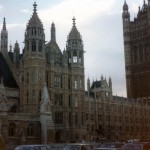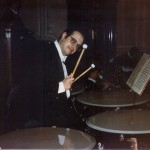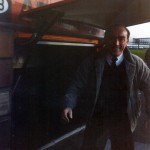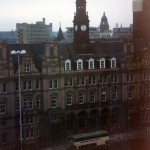My Musical Career | Part Twenty-Eight
Touring with the Oslo Philharmonic – U.K 1984
In my previous post, I talked about some of the highlights of my first seasons with the Oslo Philharmonic Orchestra. My first tour with the orchestra was an overnight run-out to Gothenberg, Sweden. My first “big” tour with the orchestra was a visit to the United Kingdom in the late fall of 1984. It was a two-week visit, and was extremely memorable for several reasons. First, as I said earlier, it was my first “big” tour with the orchestra, and second, it was the first time that I ever visited the United Kingdom.
We were to visit London, Leeds, Nottingham, Reading, Derby, Hull, Swansea, and Cardiff, just to name a few of the venues. We were to fly over to the UK on an SAS charter flight, and then be bused around the UK to the various concert locales.
All this was to happen in the latter part of November and into early December of 1984. Mariss Jansons, our chief conductor was to lead the tour. Soloists were to include Arve Tellefsen, violin, and Andras Schiff, piano.
The Progam
Music for the tour included the following: Shostakovich: Symphony No. 5 in D minor; Sibelius: Symphony No. 2 in D major, op. 43; Grieg: Incidental Music from “Peer Gynt” and his Piano Concerto; Berlioz: “Roman Carnival” Overture; Carl Nielsen’s Violin Concerto, and music from Geir Tveitt’s “Hundrad Hardingtonar”.
We would alternate programs between venues – always with an eye to making the best possible impression. On some concerts, we’d play the Sibelius Symphony No. 2 and the Nielsen Violin Concerto; in other venues we’d do Grieg and Shostakovitch. It all depended upon what the good folks wanted and how well our agents for the tour, at the time Harold Holt, Ltd.did their job.
As was to be the pattern for virtually all of our future tours, Mariss played both programs “in” in Oslo during the two weeks prior to the tour. A born orchestra builder, his preparations were intensive and comprehensive, and by the time the rehearsals and concerts in Oslo were played, we were more than ready for the tour. A great help public-relations wise was the release of the Tchaikovsky 5th Symphony on Chandos Records, The release was timed to coincide with our tour, and it, and the subsequent review by the late Edward Greenfield in the prestigious British record magazine “The Gramophone”made for an excellent calling card.
Preparing the Instruments
On previous tours, then orchestra would always take the Ludwig drums on tour, leaving the Hingers back in Oslo. The idea was to keep the Hingers in the best of condition, and let the Ludwigs endure the rougher handling that
sometimes occurs in the course of touring. In theory, this is a good idea, but I felt then, and still feel now, that when an orchestra tours, they should always put their best foot forward, so to speak, and play on the best of equipment wherever possible. There was some discussion between myself, our orchestra manager Terje Mikkelsen, and our stage manager (called the podium inspektør in Norwegian) at the time, Ove Brun. They assumed that I’d use the Ludwigs, and to be honest, if they were in a little better shape, I might have consented. Not that they were bad, but they weren’t top drawer in my estimation. I had mentioned this several times to both gentlemen, so they were well aware of how I felt. By this time, we had already started negotiations to replace the Ludwigs, so they really didn’t put up too much of a fight. The upshot was that I was able to convince them that the Hinger drums should be used for the tour. Once that was decided, proper touring cases were procured, as well as cases for the percussion, dress suits, etc. These discussions took place well in advance of the tour. The Hinger drums had been with the orchestra for about five years by this time, and I had changed the heads from the clear to the opaque, or hazy Remo. I gave them an extra going over before we left, making sure that everything that needed oiling was oiled, and that the heads were cleared, a difficult enough task given the fact that the Remo heads of the time were finicky.
I made sure my stick case was properly equipped, with the necessary mallets, mufflers, drum dial,. tuner, etc. At the time, and for many years afterward, I used a Vic Firth timpani stick case, which I still consider to be an excellent choice, as it has the required length, width and depth. For mufflers, I was still using the Vic Firth mufflers, They were, and still are good mufflers, but over the years I found them just a little too heavy for my taste, which was evolving over the course of time.
I was using Hinger mallets (both aluminum and wood-shafted) at the time, mixed in with a sprinkling of Andrew Feldmam mallets. At the time, I considered these the best mallets for my particular style of playing and I was glad of them.
Once I was assured that my equipment preparations were complete, I made sure my dress suit was clean and presentable and in the touring case. After packing my suitcase at home, it was time to bid my little family farewell and present myself at the Konserthuset in Oslo on a gray November morning, where three buses were parked, ready to transport all and sundry members of the orchestra to the smaller of the two Oslo airports, Oslo Fornebu which (after the refashioning of Gardemoen Airport in 1998) is now a series of expensive condominiums.
The tour
Over thirty years have passed since the tour, so the exact sequence of concert dates and venues are a little unclear, but I remember the main venues very well. We landed north of London as our first concerts were to take place at Newcastle and Middlesborough. The flight was uneventful, but as an Anglophile in terms of history and music, I was very excited to be in the United Kingdom and was very much looking forward to touring this historic land.
We were picked up at the airport by three red and black coaches (as buses were called in the UK). I believe they were from the Arrow Coaches, Ltd. firm. I had the great good fortune to be assigned to the one driven by an enormously capable and cheerful cockney who went by the name of Ron. He was just great, and kept all of us who rode his coach in good humor as we traveled the considerable distances
from Newcastle to Cardiff to London, etc. I think it was the accent that initially caught my interest, but as I watched him go about his job, and chatted with him, my respect for his personality and competence grew. He was a very experienced driver and knew to the minute how much time it would take to get to each venue and he would always let us know what the estimated time of arrival would be. He seemed to be able to shave about ten minutes off of each estimate – we thought of him as a “miracle worker – shades of Scotty in “Star Trek”.
We stayed over in Newcastle and played our concerts there and in Middlesborough. The venues were respectable, and the concerts there were well received. The tour began on a sad note, as Arvid Jansons, the father of our chief conductor, Mariss Jansons – and a noted conductor – died during a concert engagement in Manchester the day we landed.
Mariss had known that he was not well, but he’d been rehearsing the Halle Orchestra when he died. He was only 70, and Mariss was understandably upset. However, Mariss was also a professional, and a firm believe that the show must go on, so after all of us offered our personal condolences, the”show” did just that.
Venues and the like…
The majority of the venues were older halls, built in the early 20th century, with a pipe organ and choral seating behind the orchestra. Leeds Town Hall was memorable, as it was large and had, as I remember it, a barrel-shaped vault. A rather large pipe organ dominated the stage, with elaborately painted display pipes dominating the stage area. Acoustics were lively, but rather good. Hull, Swansea, Middlesborough and Newcastle were all of the older types, whereas St. David’s Hall in Cardiff, Royal Hall in Nottingham, Reading, and the Barbican in London were of more modern design. Acoustically, my favorites were the Royal Hall in Nottingham; St. David’s Hall in Cardiff; Leeds Town Hall, and the Barbican in London.
The halls in Nottingham and Cardiff were copies of the Berlin Philharmonie (also known at the time as the Karajan Circus) and had first-rate acoustics. Leeds was as I described above, and the Barbican had pretty good acoustics but seemed a bit drier than the others, The best facilities (dressing rooms, etc.) were to be found in Cardiff, Nottingham and London.
Hotels varied – most were about the level of a three-star level in the States. Adequate enough for our purposes, but they could have been better. The worst hotel on the tour was definitely the one in London, called the Royal Scot Hotel. The rooms were not ready when we arrived, so we had to spend the better part of a free day waiting for them to be cleaned, and when that was accomplished, were really nothing to write home about. Unfortunately, London was a hub city, and we used it as a base for the better part of a week while we did run out concerts in Derby, Reading and Portsmouth. Despite the less-than-stellar accommodations in London, I enjoyed London the most of all the tour cities. In a way, London became , over the years, a sort of second home for the orchestra during our many visits there.
During the course of this first tour, I discovered the wonders of Westminster Abbey, the Churchill War Rooms, St. Paul’s Cathedral, and of course the various HMV record shops and the book district on Tottenham Court Road, not far from St. Martin-In-The-Fields. There was located the biggest bookshop I had ever encountered – Foyles. Six floors of books-books-books! Being a bookworm and audiophile, you can be sure that I felt like that I had died and gone to heaven!
The Concerts
The concerts themselves went off very well, as was to be expected as we had prepared ourselves beforehand. If I have to name three outstanding concerts of this tour, I would have to single out London (where we played at the Barbican); Leeds, and Cardiff. Reviews were generally good for the entire tour, but were particularly good for these
three venues. All of us were very satisfied, and enjoyed ourselves immensely. One of the bright spots of this tour (and for most of our subsequent tours) was the fact that we played in venues that were by and large far superior acoustically than our own Oslo Concert Hall. I have inveighed against that hall many times in previous blog entries. Any change was an improvement, and in playing at the Barbican, St. David’s Hall in Cardiff, and Leeds Town Hall we were able to hear ourselves much better and therefore give a better account of ourselves then was possible in Oslo. After the concert at the Barbican, which was the final concert on the tour, a reception was given for the orchestra in an upstairs banqueting hall. Here, we mingled with members of the audience, which included some bigwigs from Harold Holt, Ltd, our tour managers, and recording firms such as Decca. It was here that I had the good fortune to meet and have a conversation with the legendary Decca recording producer Christoper Raeburn, who was at one time an assistant producer to John Culshaw during the recording of Wagner’s Ring in the late 50s and early to mid 60s. He was a pleasant individual and extremely knowledgeable and we chatted about everything from the Ring to modern recording techniques. It was quite the conversation.
Before I close, let me not forget to list the members of them percussion section who did a super job: Per Erik Thorsen, principal; Trygve Wefring, assistant timpanist and second percussion; Per Melsæter, third percussion, and Bjørn Løken, extra percussion. We all gave of our best, and it was a tour to remember.





Recent Comments